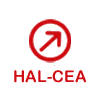Mixed-ligand uranyl ion complexes with two flexible, pyridinium-based dicarboxylate zwitterions and simple anionic dicarboxylates
Résumé
Two new dizwitterionic dicarboxylates, E-bis(N-(2′-carboxylatoethyl)pyridinium-4-yl)ethene (L1) and E-bis(3-carboxylatopyridiniomethyl)ethene (L2) have been reacted with uranyl nitrate hexahydrate under solvo-hydrothermal conditions, in the presence of dianionic dicarboxylates, yielding a series of 7 complexes which have been characterized by their crystal structure and luminescence properties. Both [(UO2)2(L1)(1,2-pda)2]·2H2O (1) and [(UO2)2(L1)(1,4-pda)2]·H2O (2), where 1,2- and 1,4-pda2− are 1,2- and 1,4-phenylenediacetates, crystallize as monoperiodic coordination polymers, either two-stranded and ladder-like or sinuous and daisychain-like, respectively. [(UO2)2(L1)(t-1,4-chdc)2] (3), where t-1,4-chdc2− is trans-1,4-cyclohexanedicarboxylate, is a diperiodic assembly with the hcb topology. In situ formation of oxalate anions (ox2−) produces [(UO2)2(L2)(ox)(OH)2] (4), a diperiodic coordination polymer containing dihydroxo-bridged, dinuclear subunits. Simple chains are found in [(UO2)2(L2)(pht)2(H2O)2]·2H2O (5), where pht2− is phthalate, while [(UO2)2(L2)(ipht)2]·2H2O·2CH3CN (6), where ipht2− is isophthalate, is another hcb network. In all these cases, each dicarboxylate ligand connects two metal centres. Finally, [(UO2)2(L2)(t-1,4-chdc)2] (7) is a triperiodic framework with the unusual mog topology, in which t-1,4-chdc2− is either bis(κ2O,O′-chelating) or bis(μ2-κ1O:κ1O′-bridging). Bond valence calculations reveal no very significant difference in donor strength between the two types of ligands. The importance of weak interactions (hydrogen bonding, π–π stacking) is discussed. Only complex 5 is strongly emissive in the solid state, with a photoluminescence quantum yield of 19%, and 6 is weakly emissive (4%), while 1–3 and 7 are non-emissive. The spectra of 5 and 6 display the usual vibronic fine structure, the peak positions being dependent on the uranyl ion equatorial environment.
Domaines
Chimie| Origine | Publication financée par une institution |
|---|---|
| licence |




